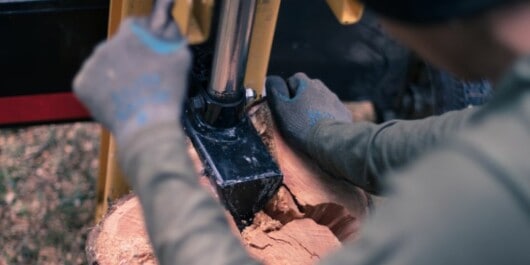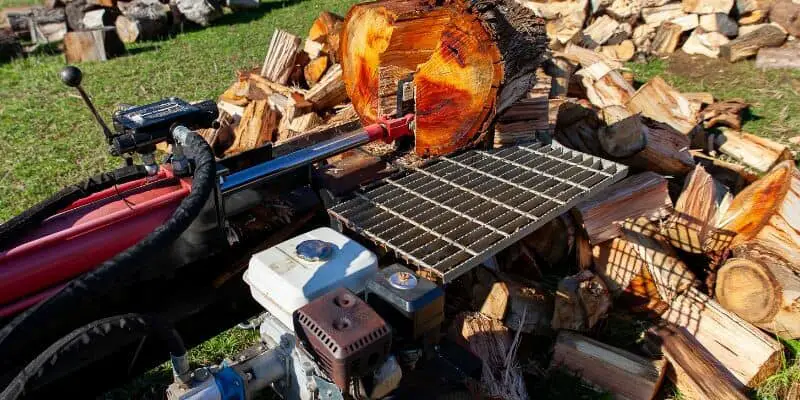Are you a log splitter user looking for ways to speed up your hydraulic log splitter? If yes, then you are certainly in the right place at the right time.
Speeding up, a hydraulic wood splitter is possible if you need more force to split the wooden logs. It can be done by upgrading the hydraulic fluid pump, purchasing a 2-stage hydraulic pump, or implementing a 3-way valve. You can also increase the speed by providing more pressure or using a larger cylinder in your log splitter.
In this guide, you’ll get to know all about speeding up your log splitter, how do you speed up a hydraulic wood splitter, increasing the cycle time, and more. Continue reading to get all the answers that you are looking for.
How to increase the force and speed of your log splitter?
Hydraulic pressure produces force, while hydraulic flow produces speed. If you are looking to get more force, you should either apply more pressure or use a larger cylinder. The pressure is something that you probably cannot change much. You need to check the relief setting on the directional valve, as it controls the maximum. It is recommended that you shouldn’t go more than 2500 PSI, which is the maximum for most gear pumps.
Yes, there are a few options that are rated 3000 PSI or higher. But that would be like driving your car at a speed of 125 MPH. It might be thrilling to do so at times, but you won’t be able to do it all the time. It wouldn’t be such a great idea. Almost all log splitter pumps come rated for the same pressure. Bigger gears are capable of producing more flow, which means more speed. Moreover, you’ll require more horsepower for using them. To get more force, you will require a larger bore cylinder. If you’re looking to get the same speed as a smaller cylinder, you’ll require a larger pump and a larger engine to drive it.
If you’re after more speed, you should either go for more flow (GPM) or use a smaller cylinder. The smaller cylinder will not require more power, but it will certainly produce less force. More flow will come from a larger pump. So, you will be able to get the same force, but you’ll have to supply more horsepower to the new pump.
Another factor to consider for a log splitter cylinder is the rod diameter. The larger the rod, the faster the log splitter’s cylinder will retract. Of course, it will also increase the cost of the cylinder, but if you’ve got the choice, you should choose the cylinder with the larger rod.
How to increase the flow in a hydraulic log splitter over time?
In terms of a hydraulic log splitter, a reduction in performance is often the first clue that a problem is arising in the machine. It is often indicated by longer cycle times and slower operation. The root cause of the failure symptoms can be traced to the fluid flow. The fluid flow in a hydraulic log splitter will determine the actuator speed and quickness of response. Moreover, loss of flow will also equate to loss of speed.
Applying this logic to an increased cylinder speed will mean that more flow is occurring in your log splitter. Here is how you can increase the flow in a hydraulic log splitter over time –
- Internal leakage – If the internal leak becomes clogged, the flow will inherently increase
- Filter collapse or bypass malfunction – If the filter is causing reduced flow and bursting, or there was a malfunction with the bypass that was allowing the flow to increase, both of them would result in an increased cylinder speed
- Viscosity change – If the viscosity decreases, the flow will increase, depending on the system design and pump
- Oil line cleared – If a blocked or restricted oil line becomes unrestricted/unblocked, the flow of fluid will increase
- Air entertainment – The air in the fluid could cause poor or slow performance and once the air problem is resolved, the log splitter will automatically speed up
- Change in load – If the load on the hydraulic cylinder gets reduced, it might increase the cylinder speed

How do you speed up a hydraulic wood splitter?
An average log splitter cuts wood way quicker than any ax. However, if you really want to split the wood properly and get over with the task quickly, you might need to speed up the log splitter’s speed or cycle time. Here are some of the ways how do you speed up a hydraulic log splitter –
1. Make use of a 3-way valve
Using a 3-way valve, you’ll be able to speed up the forward stroke while at the same time reducing the splitting force in proportions. The extra valve will consist of a standard port that is connecting to other ports. The second valve port is connected to the line that goes to the rod end of the cylinder directly. Coming to the remaining port, it will join into the line feeding the base end of the cylinder with the tee fitting.
2. Upgrade the hydraulic fluid pump
For increasing the cycle time, you’ll require a bigger hydraulic fluid pump. However, this can also mean having to increase the size of your hydraulic tank. You will have to make sure that you prevent the hydraulic fluid from overheating. For accommodating the increased hydraulic fluid flow, you’ll need to have bigger hydraulic hoses and larger supply lines.
3. Use a 2-stage hydraulic pump
Another potential option to use would be a 2-stage hydraulic pump. There are two modes of operation that are used in a 2-stage hydraulic pump. If the return stroke doesn’t have any load, it’ll be able to pump a considerably bigger volume at low pressure while also moving the ram back quickly. The pressure increases, and the pump switches back to the high-pressure mode once the ram meets the wood. Basically, a 2-stage hydraulic pump will help accelerate the entire process by requiring less power in moving the splitting ram.
How to adjust pressure and increase speed in a log splitter?
Harder woods will require more force for splitting successfully. Luckily, you won’t have to purchase separate log splitters for catering to every kind of wood. Instead, you can just adjust the pump pressure, and you’ll be ready to go. The engine on the log splitter is pretty easy to navigate, so there won’t be any need to hire professional services to adjust the pressure. Instead, here are steps that you will need to follow –
1. Start the log splitter
The first step would be to start your log splitter’s engine. Turning on the log splitter’s engine will help you know the capacity of the engine. Once you’ve turned on the engine, wait for the hydraulic to properly warm up. You should only proceed to the next step once the engine has reached its idling speed.
2. Expose the pump
Now, you should set down the log splitter guards while exposing the pump.
3. Set the pump to neutral
Locate the pump level and then set it to neutral.
4. Adjust the pressure
For testing the pressure capacity of the pump, you should adjust the screw with a flat-blade screwdriver. The pressure will increase as you’re turning the screw clockwise, while it’ll decrease as you’re turning the pressure counter-clockwise.
5. Put the shield back
Once you’ve set the desired pressure, you shouldn’t forget to put back the shield for protection.
Speeding up your log splitter will cost a fair bit of money. If you are splitting wooden logs by yourself, there is no need to speed up the log splitter’s cycle time. The machine would have already done wood splitting by the time you have grabbed the next log. However, if you are splitting with someone else, spending a few bucks on improvements will still be a practical option.
FAQs
Why is my log splitter so slow?
A slow log splitter is caused by issues with the hydraulics, fan, pump, ram, power supply, or cylinder. Checking each element one by one will help you identify the cause of the issue.
What factors determine the speed of the log splitter?
The log splitter speed is determined by the volume of the fluid flow, or gallons per minute (GPM). For increasing the speed of the log splitter’s operation, a bigger hydraulic pump will be needed, as it’ll pump more volume of hydraulic fluid.
What is considered to be a good cycle time for a log splitter?
With a hydraulic log splitter, be it an electric or gas-powered one, you will have a rough average cycle time of 12-15 seconds. Meanwhile, with a kinetic log splitter, the average cycle time could be as low as 2 seconds.


